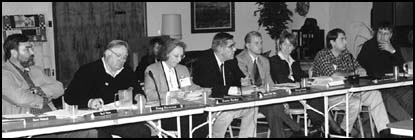 Chicken producers from central Minnesota testified before the House Agriculture and Rural Development Finance Committee at the Paynesville Area Center on Wednesday, Dec. 1.
Chicken producers from central Minnesota testified before the House Agriculture and Rural Development Finance Committee at the Paynesville Area Center on Wednesday, Dec. 1.The House committee is holding more than 14 listening sessions and five agribusiness tours across Minnesota over a three-month period. Topics covered by the listening sessions range from farm credit to the pork industry, from sustainable farming to ethanol, and from producer contracts to reporting regulations.
Legislators in Paynesville Wednesday afternoon were: Bob Ness, R-Dassel, chairman of the House Agriculture Committee; Doug Peterson, D-Madison; Rod Skoe, D-Clearbrook; Elaine Harder, R-Jackson; Doug Stang, R-Cold Spring; Torrey Westrom, R-Elbow Lake; Al Juhnke, D-Spicer; and Senator Michelle Fischbach, R-Paynesville.
Jodi Day, executive director of the Broiler and Egg Association and Turkey Growers Association, was the first person to address the committee in Paynesville Wednesday afternoon.
She explained that in 1975 there were 10,000 chicken egg operations in the country. By 1985, that number had dropped to 3,000 operations and by 1996 there were only 900 egg operations.
"We have to be competitive," Day said. Minnesota ranks seventh in chicken production. "Recently, Minnesota lost two significant egg plants to Iowa because of feedlot permit regulations," she added. "Environmental regulations have played a major role in where businesses locate new plants."
Michael Helgeson and Ralph Michaelson presented an overview of Gold'n Plump Poultry. The company has its headquarters in St. Cloud and a large plant in Cold Spring.
Michaelson informed the committee that feedlot issues and changing pollution control rules were their big issues. "Rules should be based on good scientific data and common sense," Michaelson said. "There are several issues not resolved. Among them are animal unit definition, manure handling, permit fees, and odor management.
John Klaphake, a breeder and grower for Gold'n Plump in Freeport, stressed there needs to be a clarification on animal units which are used for permits. For barns holding under 1,000 birds, the permit fee is approximately $250 per year. For anything over 1,000 birds, the fees jump significantly.
"I don't feel there are any more pollutants with the chicken industry than dairy, maybe even less," Klaphake added. "I have 560 acres on which I spread the manure."
Dan Schroeder, a Farming Township broiler grower, told the committee it costs about $300,000 to erect a new facility. He raises 52,000 chickens in his barn now. The barn is emptied about every six weeks.
Ness asked about how many birds Gold'n Plump has on their farms at a given time. Michaelson replied six to 6.5 million on any given day in various stages of growth.
"Most of our chicken facilities are within 40 miles of St. Cloud," Michaelson said. "For growth to occur within the industry, Minnesota must create a favorable business environment. Rules need to be equitable with other states for us to be competitive."
John Muller of Sparboe Companies, headquartered in Litchfield, told the committee that many prospective processing plants are going south of the border (to Iowa) because of a better business climate (feedlot regulations)," Mueller said.
Ness questioned Muller about the proposed feedlot permit fees. Muller replied they can be as high as $12,000. Rep. Doug Peterson asked what was the difference between Minnesota and Iowa. "Less scrutiny," Muller replied.
Amon Baer, a Lake Park egg producer, stressed the importance of changing the feedlot permit rules. "The Minnesota Pollution Control Agency (MPCA) lumps everything together. Animal permits are specific about not discharging to the waters of the state. Our facility is totally enclosed with no runoff.
"Farmers can be fined $5,000 per day for a paper work violation. The MPCA expects farmers to record on what field manure was spread, how applied, and when," Baer said.
He told the committee he lives on the border of two counties and two townships. "My employees don't always know which county or township they are in when driving from field to field. We have clipboards in the tractor cabs to record everything. However, many times the driver needs a quick piece of paper to write a repair number upon and there goes the distribution records," Baer said.
Baer said another issue for him is the animal units. He thought feedlots should be treated differently. Instead of by animal units, the MPCA should look at how different feedlots handle their manure and regulate accordingly.
Baer added that farm businesses, such as Cenex, are regulated differently than he is when spreading organic fertilizer. Shouldn't we be treated the same. "We are both spreading organic fertilizer." Baer said.
The number of animal units has nothing to do with discharge, Baer felt. The MPCA should be concerned with individual feedlot discharge practices and how they spread their manure, Baer said.
He informed the committee one 1,000 pound steer is considered a unit while 100 chickens (350 pounds) is considered a unit. "There is a big weight difference between one steer and 100 chickens," Baer said. The proposed MPCA rule treats a five-pound turkey the same as a 1.4 pound pullet.